|
|
SANSKRIT IMAGES
By Permission
From: Tobifudo

Handbook on Viewing Buddhist Statues
A totally wonderful
book. Many images
shown on this page
were scanned from
this book; Japanese language only; 192 pages; 80 or so
color photos.
Click here to
buy book at Amazon
仏像の見方
ハンドブック
石井 亜矢子 (著)
by Ishii Ayako
|
|

Nikkō 日光 & Gakkō 月光
Nikkō (Sunlight Bosatsu) & Gakkō (Moonlight Bosatsu)
Hindu Counterparts Nitten 日天 (Sūrya, Āditya) & Gatten 月天 (Candra)
ORIGIN = INDIA
 Siblings who serve the Yakushi Nyorai. Nikkō (Nikko) is the Bodhisattva of Sunlight (Solar Radiance) and Gakkō (Gakko) is the Bodhisattva of Moonlight (Lunar Radiance). They are sometimes depicted holding solar and lunar symbols, with Nikkō grasping a red solar disc 日輪 and Gakkō a white lunar disc 月輪. The two appear most frequently as kyōji 脇侍 (two attendants on either side of the central statue; sometimes pronounced “wakiji”) to Yakushi Nyorai in a triad known as the Yakushi Sanzon 薬師三尊. Typically Nikkō is to the left and Gakkō to the right of the central statue. Less frequently, they are paired with Senju Kannon 千手観音 (as at Dōjōji Temple 道成寺 in Wakayama prefecture) or with Fukūkenjaku Kannon 不空羂索 (as at Tōdaiji Temple 東大寺 in Nara; see photo below). Nonetheless, it is difficult to tell the two apart, for differences in dress, placement (right or left of the main image), and iconography (inner or outer arms raised) are not always consistent in Japan. Siblings who serve the Yakushi Nyorai. Nikkō (Nikko) is the Bodhisattva of Sunlight (Solar Radiance) and Gakkō (Gakko) is the Bodhisattva of Moonlight (Lunar Radiance). They are sometimes depicted holding solar and lunar symbols, with Nikkō grasping a red solar disc 日輪 and Gakkō a white lunar disc 月輪. The two appear most frequently as kyōji 脇侍 (two attendants on either side of the central statue; sometimes pronounced “wakiji”) to Yakushi Nyorai in a triad known as the Yakushi Sanzon 薬師三尊. Typically Nikkō is to the left and Gakkō to the right of the central statue. Less frequently, they are paired with Senju Kannon 千手観音 (as at Dōjōji Temple 道成寺 in Wakayama prefecture) or with Fukūkenjaku Kannon 不空羂索 (as at Tōdaiji Temple 東大寺 in Nara; see photo below). Nonetheless, it is difficult to tell the two apart, for differences in dress, placement (right or left of the main image), and iconography (inner or outer arms raised) are not always consistent in Japan.
One way to distinquish between the two is to look for the Nichirin symbol (日輪 = Sun Disc) or the Gachirin symbol (月輪 = Moon Disc). The Nichirin is a round circle, typically red in color, and held by Nikko. The circular sun disc is also used frequently as the halo for deities like Aizen Myo-o and Dainichi Nyorai. The moon disc, the Gachirin (also called Gatsurin or Getsurin), is a perfectly round circle, typically white, meant to represent the full moon, a frequently used symbol in Buddhist painting and sculpture. It represents the Buddha’s knowledge and virtue and symbolizes the aspirations of sentient beings to attain Buddhahood. The Gachirin is a key attribute of Gakko Bosatsu, who is often shown in statues and paintings wearing a headpiece representing the moon or holding a circular form in the palm of his hand. In the Kongōkai Mandala 金剛界曼荼羅 of Esoteric Buddhism, moreover, each of the nine divinities is shown seated in the circle of a full moon. The Gachirin is also found often on Buddhist grave stones called Gorinto.
Nikkō’s Shingon Mantra (真言宗真言)
おん ろぼじゅた そわか
On Robojyuta Sowaka
also おん そりや はらばや そわか
Gakkō’s Shingon Mantra (真言宗真言)
おん せんだら はらばや そわか
On Sendara Harabaya Sowaka

|
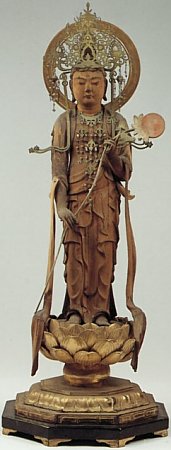
|
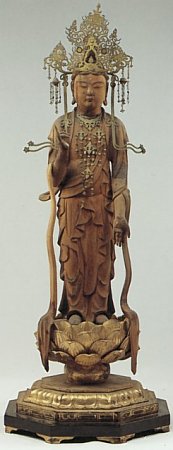
|
|
Nikkō Bosatsu (holding red disc) & Gakkō Bosatsu. Important Cultural Properties of Zushi City, Japan.
Dated: Muromachi Period, 15th-16th Century, Wood. Jinmuji Temple 神武寺 (Tendai Sect) in Zushi City.
Yosegi Zukuri 寄木造 (Joined-Block Technique). Height: 58.0 cm and 59.5 cm.
The two surround the main object of worship, a seated statue of Yakushi Nyorai located within the temple’s Yakushi Hall 薬師堂 (see image below). This Yakushi Triad 薬師三尊 (Yakushi Sanzon) is a Hidden Buddha 秘仏 (Hibutsu) and shown only once every 33 years. The next public showing will occur in 2017. However, the temple performs its annual housekeeping each year on December 13. In the morning, during this annual event, the triad is available for viewing and veneration. <Photos Courtesy Zushi City, Kanagawa Prefecture>
|
|
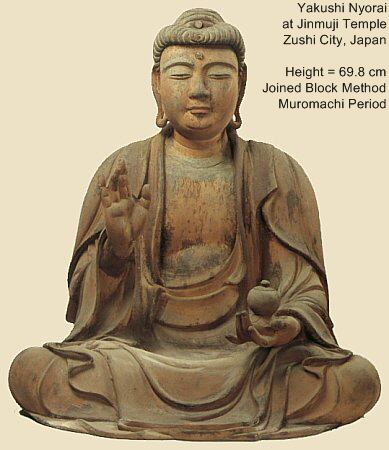
|
|

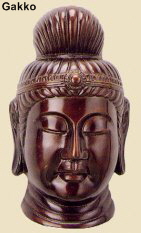 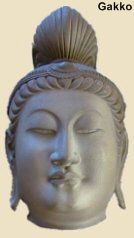
Gakko, Modern, for sale at butuzou.com
Gakko, Modern, for sale at cyberoz.net/city/sanden/

 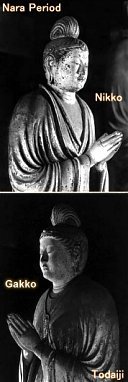  Nikko and Gakko at Todai-ji Temple, Nara Nikko and Gakko at Todai-ji Temple, Nara
Below text courtesy art-and-archaeology.com
Although traditionally called Nikko and Gakko, these clay statues (746) may actually represent Brahma and Indra. They flank a large Fukukenjaku Kannon (see photo near bottom of this page) in the Sangatsu-do at Todai-ji. At 7 1/2 feet in height, the statues are larger than life size, although they are still dwarfed by the 12-foot high Kannon.
Nikko and Gakko usually appear as attendants of Yakushi Nyorai, but in the photo at right and below they attend the Fukukenjaku Kannon. It is difficult to distinguish between Nikko and Gakko, for their depictions in Japanese sculpture and art are inconsistent.
Differences in dress, placement (right or left of the main image), and stance (inner or outer arms raised) can lend clues to help identify the two, but such differences are not consistent.
For example, at Todai-ji, To-ji and Yakushi-ji, Nikko stands to the viewer's right, with Gakko positioned to the viewer's left. But at Kakuon-ji in Kamakura, Nikko is to the viewer's left while Gakko is positioned at the viewer's right. Two B&W photos courtesy www.art-and-archaeology.com.

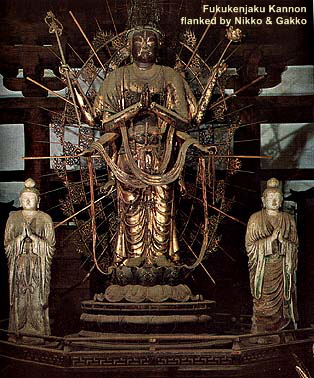
Fukūkenjaku Kannon 不空羂索
Flanked by Nikko (right) and Gakko (left)
with hands in the Gassho mudra (prayer, veneration).
746 AD, Dry Lacquer, Tōdaiji Temple 東大寺 (Nara)
Photo courtesy www.art-and-archaeology.com
The Fukukenjaku 不空羂索 (Fukūkenjaku) Kannon at Tōdaiji Temple 東大寺 in Nara stands 12 feet high. It dates to 746 AD and is made of dry lacquer. The Kannon is flanked by Nikko (to right of main statue) and Gakko (to left). This form of Kannon has eight arms. Fukukenjaku means "never empty lasso." It refers to the coil of rope which the Kannon holds in one of the lower arms (viewer's right). Kannon uses this rope to catch straying souls and lead them to salvation. The lasso is found in other multi-armed forms of Kannon as well.

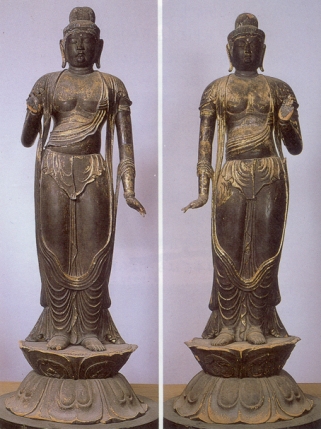
Nikkō and Gakkō
Heian Era, Shōjyo-ji in Fukushima
Photo courtesy Handbook on Viewing Buddhist Statues

|
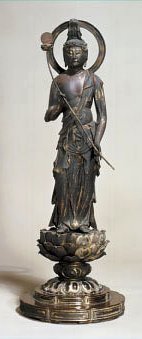
|
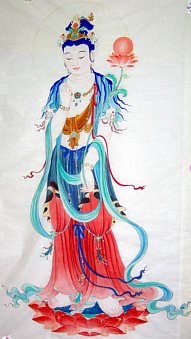
|
|
Nikkō Bosatsu
(holding sun disc)
Important Cultural Property
Japan, 13th century
Figure H = 63.7 cm
Hinoki (Cypress) with Lacquer
Fukuoka Art Museum, Japan
|
Nikkō Bodhisattva
(holding red sun disc)
Modern
Chinese Painting
Photo Courtesy
this Chinese site
|
|

|
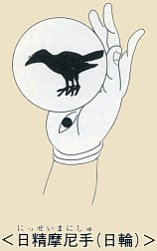
日精摩尼手 (にっせいまにしゅ)
Nichirin (sun disc) with a black three-legged crow drawn inside. In Japan, Nikkō Bosatsu is associated with a black three-legged crow, as are other deities including Myōken (the deification of the Pole Star and the Big Dipper), Emperor Jimmu 神武天皇 (Japan’s legendary first emperor), and Nōjo Taishi 能除太子 (the founder of Haguro Shugendō). People with eye disease or poor eye sight in Japan can purchase talismans or icons called Nissei Manishu 日精摩尼手, which show the 3-legged bird inside the sun disc. Making proper pleas and prayers to the icon is said to cure one's eye problems. Let us recall that Myōken literally means “wonderous sight.”
Why the three legs and why the black crow inside a sun disk? The most plausible reasons involve Chinese mythology and Japan’s own creation legends. First, a black three-legged crow known in China as Sānzúwū 三足烏 (lit. = three-legged bird) appears in Chinese artwork dated to the Yǎngsháo 仰韶 period (5000 BC to 3000 BC). In Chinese mythology and ancient philosophical texts, this bird is intimately related to the sun. It has three legs, according to the Huáinánzǐ 淮南子(2nd century BC Chinese text), because three is the emblem of Yang -- and the supreme essence of Yang is the sun.
Second, in Japan’s own creation myths, including the Nihon Shoki 日本書紀 (submitted to the Japanese imperial court in 720 AD), a giant crow called Yata-garasu 八咫烏 (eight-span crow) appeared to Japan’s first emperor, Jimmu 神武天皇, who had landed on the shores of Japan but gotten lost. The crow was sent by Amaterasu Ōmikami 天照大神 (Japan’s supreme sun goddess) to lead Jimmu to Yamato (the heartland of Japan). Says site contributor Cate Kodo Juno, an ordained Buddhist priest of Japan's Shingon sect: “Since the crow is also associated with Myōken and the Pole Star, could it be that it was the Pole Star that guided Jimmu?”
Third, according to Maison Franco-Japonaise (which translated the film Shugen: The Autumn Peak of Haguro Shugendō): “The founder of Haguro Shugendō is Nōjo Taishi 能除太子, who is said to have come to Haguro early in the seventh century. He was given the title of Shōken Daibosatsu 照見大菩薩 in the 19th century. Legend says he was the third son of the late sixth century emperor Sushun 崇峻天皇 (reigned 587 to 592), and the cousin of Shōtoku Taishi (574-622), Japan’s first great patron of Buddhism. According to legend, prince Nōjo renounced his title and position, took the name Kōkai 弘海, and became a wandering hermit of the mountains. Nōjo is depicted as a strange being, dark of skin and with exaggerated facial features, his mouth extending from ear to ear. It was to a place called Akoya, in a narrow valley full of thick growth, with a waterfall at one end, that Nōjo was guided by a mystical three-legged crow, and it was here that he first did ascetic training. Here also he found a statue of Kannon Bosatsu and it was from here that he founded the three sacred mountains (Dewa Sanzan) as a Shugendō site.” Site contributor Cate Kodo Juno offers another asute observation: “It is most likely that the story of Haguro Shugendō founder Nōjo Taishi is emulating the story of Emperor Jimmu, as often happens in hagiographies, in order to provide added legitimacy and authority to Nōjo’s legend.”
Some final words on the above Shugendō legend. Today people equate the three-legged bird with the three sacred mountains of Dewa Sanzan, but the basis of the legend goes back to earlier Chinese mythology. Also, Myōken, the deification of the Pole Star and Big Dipper, is a major star deity at sacred Mt. Haguro, one who is said to possess the power to cure eye diseases.
|
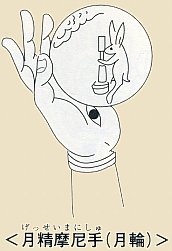
月精摩尼手 (げっせいまにしゅ)
Gachirin (moon disc) with a rabbit pounding mochi (glutinous rice) drawn inside. In Japan, Gakkō is also associated with a hare. People suffering high temperatures or fevers can purchase such talismans or icons (called Gessei Manishu 月精摩尼手), which are said to reduce fever and cool the body.
Why the rabbit? In the West, when people look at the moon, they see a man in it. The Chinese see a rabbit, pounding magical herbs to make the elixir of eternal life. The Japanese, with their love of obscure wordplays, envision the same rabbit pounding rice to make mochi. The name of the full moon is mochizuki, while mochitsuki means “making mochi.”
The Rabbit is also associated with the Zodiac calendar. For more on rabbit lore in China and Japan, see Gabi Greve’s site.
Clipart above from: 日本仏像大全書 (Big Catalog of Japan's Buddhist Statues). Published in Japan by 四季社 (Shikisha), 2006. ISBN4-88405-335-4 C0095. Japanese only, 530 pages. Lots of B&W clipart.
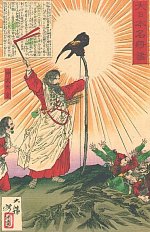
Emperor Jimmu and 3-legged crow.
Artwork by Tsukioka Yoshitoshi
月岡芳年 (1839-1892).
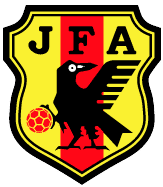
Three-Legged Black Crow
Logo of the Japan Football Association
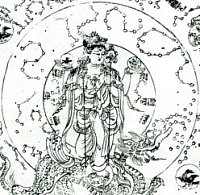
Myōken atop dragon holding sun and moon discs.
Holding sun disk with 3-legged black crow,
and moon disk with hare and frog.
Photo from Besson Zakki 別尊雑記, a Buddhist
text compiled by Shingon monk Shinkaku 心覚
(1116-1180) and translated as "Miscellaneous
Record of Classified Sacred Images."
Also called the Gojukkanshō 五十巻抄.
|
|

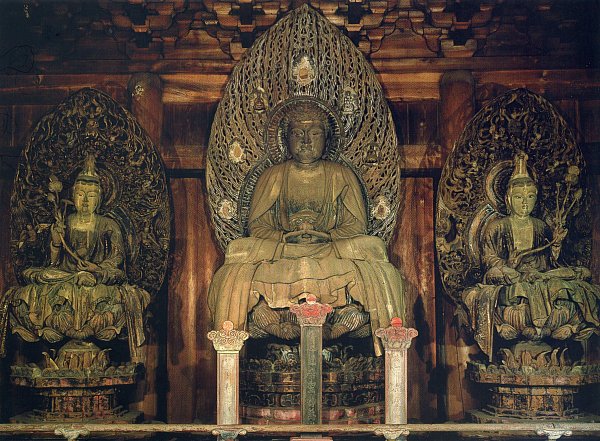
Yakushi Triad (Yakushi Sanzon 薬師三尊) at Kakuonji Temple, Kamakura. ICA.
Nikkō Bosatsu on left (to your right) and Gakkō Bosatsu on right (to your left).
Nikkō (Sunlight) and Gakkō (Moonlight) statues attributed to sculptor Chōyū. Dated to 1422. H = 149.4 cm.
Inscription found in head of Nikkō statue says it was carved in 1422 by local sculptor Chōyū.
Central Yakushi image: H = 181.2 cm. Head dated to Kamakura Period and body to Muromachi Period.
The original central statue (attributed to Unkei) was destroyed in a fire in 1251 and remade in 1263.
The hanging vestments (hōesuikashiki 法衣垂下式), the large rahotsu 螺髪 (hair on head in spiral curls),
the facial features, and the slender fingers clearly reflect the influence of China’s Sung period (Sōdai 宋代).
These features also suggest that the Kamakura Busshi wanted to be independent from Kyoto culture or to rival it.
<Sources: Kondo Takahiro; Kakuonji Temple; Photo from magazine 日本の仏像, 2007/10/25, No. 19 (Kondansha).>

LEARN MORE
- ART AND TEMPLES OF JAPAN. www.art-and-archaeology.com/japan/japan.html. Wonderful site presenting numerous Japanese temples and photos of temple architecture and Buddhist statuary.
- JAANUS entry on Nikko and Gakko. Says JAANUS (abbreviated passage): Among Japan’s Esoteric Buddhist sects (Mikkyō 密教), Nikkō appears in the Jogaishōin 除蓋障院 section of the Matrix Mandala (Taizōkai Mandara 胎蔵界曼荼羅) and is also identified with Kongōkō 金剛光 (Skt = Vajrateja) among the 16 Great Bodhisattvas (Jūroku Daibosatsu 十六大菩薩) of the Diamond World Mandala (Kongōkai Mandara 金剛界曼荼羅), while Gakkō appears in the Monjuin 文殊院 section of the Taizōkai Mandala and is included among the 16 Deities of the Auspicious Aeon (Gengō Jūrokuson 賢劫十六尊) in the Kongōkai Mandala. Editor’s note. Mandala details here.

Last Update October 2010. Added new photos and text.
|
|